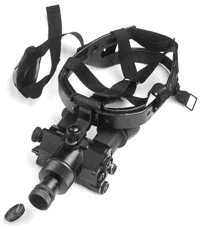
Iceberg of high technologies of the domestic military-industrial complex.
Salikov Vyacheslav Lvovich
Review of the market of night vision devices of Russian production.
The last decade of the twentieth century was distinguished by a significant increase in attention to night vision devices (NVD) from consumers, inspiring optimism in the heads of the domestic optical industry.
In addition to traditional orders for the production of military NVDs, which are rapidly increasing due to the obvious successes of night combat tactics using II+ and III generation converters, demonstrated mainly by the United States and its NATO allies, the market for civilian NVDs is also developing very rapidly.
The latter should include not only amateur devices of the zero and first generations, which are often used for professional purposes, but also the same military systems adapted for the needs of rescue services, provision of law enforcement personnel and security.
It should be noted that from the entire variety of NVDs, only the market segment of wearable and portable devices for individual use, i.e. glasses, monoculars, sights — both head-mounted and those providing observation from the hand or mounted on a weapon — was selected for review in this article.
Stationary and semi-stationary night vision devices, such as night driving devices for special vehicles and navigation systems for ships, with rare exceptions, should be considered as part of the products for which they were developed for use in night conditions.
The disappearance of the political barrier that not long ago divided the world into blocks predetermined the structural globalization of the economy and, as a consequence, the availability of military technology products from various countries of the world.
Each state, caring about the needs of its own defense and security, independently developed or borrowed a similar series of night vision devices that met established standards.
The spontaneous democratization of an initially isolated market led to a conversion that was aggravated by the lack of competent marketing on the part of many companies, predetermining a significant range of products on offer and tough competition.
As a result, potential buyers now have a fairly wide choice among devices with approximately the same parameters.
The specifications published in passports and advertisements say little to non-specialists in IR technology and practically nothing about the level of the manufacturer and the quality of its products. In the current situation, a review and brief analysis of the state of the Russian NVD market may be useful.
A classic example of the diversity of homogeneous forms can be considered night vision goggles (NVG), in particular, those built according to a pseudo-binocular scheme.
Such devices are mounted on the operator's head on special masks to ensure movement and orientation on the terrain at night, covert observation of objects, performance of various types of engineering and technical work, and control of vehicles over rough terrain without using visible light sources at night.
The main characteristics of the glasses and the most famous domestic model 1PN74, developed for the national Armed Forces (photo 1), were already mentioned in the previous issue of the magazine.
Photo 1. Night vision glasses 1PN74.
The appearance of the ONV Sova-B1 manufactured by «NPZ» (Novosibirsk), produced in a shockproof polystyrene case (photo 2), has aroused great interest.
However, the parameters of this device, as well as other analogues, are not much different (comparative characteristics of the glasses in question are given in Table 1), and the design «in iron», i.e. in a silumin case, is considered more preferable among specialists.
The significant weight of the Sova is also disconcerting.: without a mask, the weight of the glasses is 700g, and when equipped (with a mask and power sources) — more than a kilogram.
In the final version, the glasses were called — Nyrok.
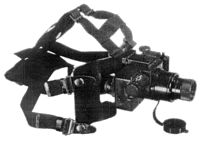
Photo 2. Night vision device Sova-B1
NVG Kremlin-1/2 looks attractive, manufactured by Novosibirsk JSC «Katod» (photo 3).
Initially, the optical and mechanical units of these glasses were assembled in a thin-walled welded metal case.
The optical design is more advanced due to the use of eyepieces with an increased diameter of the exit pupils — up to 18 mm, versus 8-10 mm in traditional models.
It should be borne in mind that achieving a diameter of the exit pupils of the eyepieces greater than 14 mm allows one to get rid of the mechanism of adjustment based on the operator's eye base (the distance between the centers of the pupils in different people varies from 56 to 72 mm, and the diameter of the pupil of the eye when observing the EOP screen in the eyepiece is 64 8 mm).
An increase in the pupil diameter leads to a decrease in the brightness of the observed image proportionally to the ratio of the areas of the normal and enlarged pupils (in this case — up to 3 times), but the achieved value of the gain coefficient of modern image intensifiers allows for compensation of losses due to the built-in gain control.
The absence of a mechanism for adjusting the eye base allows for a return to separate mechanisms for diopter adjustment of the eyepieces, otherwise, the adjustment is made from the image intensifier by shifting its relative ocular system.
At comparative tests of the Kremlin ONVmade the most favorable impression on representatives of special forces, although the technical characteristics of this model do not differ significantly from the classic ones, with the exception of ergonomics, which is possibly one of the best.
However, experts considered the design of the Kremlin case to be somewhat «liquid», i.e. more susceptible to minor deformation under mechanical loads and temperature changes than a cast «box», and for subsequent production a model in a cast plastic case was developed.
According to the developers, this allowed to reduce the dimensions of the design to the maximum.
The advantage of the models under consideration is that they are equipped with a replaceable mirror-lens objective, screwed onto the body instead of the main one, which allows you to easily turn the glasses into binoculars with 4x magnification.
Kremlin is one of the smallest and lightest pseudo-binocular binoculars among those currently produced.
When using NVG binoculars, it is necessary to take into account that changing lenses in the field is undesirable due to the possibility of contamination of the open surfaces of the optical elements.
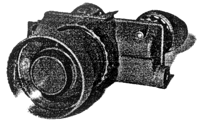
Photo 3. Kremlin pseudo-binocular glasses
The NVG model GEO-NV-III-NG is distinguished by its original case design and very high characteristics., developed by the research and production association «Geophysics-NV» (Moscow) specifically for the use of III-generation EOPs, the production of which is the company's priority.
Nevertheless, the «GEO» glasses did not become widespread due to the high price, which was predetermined by the EOP-III used and several worse weight and size parameters than the analogues of the GEO-NV-III ONV have not undergone technological preparation and launch into serial production and can be produced only individually, which leads, for example, to the need to manufacture body parts on a milling machine from solid duralumin blanks.
Recently, representatives of the company conducted field tests of the 1PN74 model, serially produced by the State Unitary Enterprise «Alpha», Moscow, specially adapted for the use of the EOP-III produced by «Geophysics-NV», which is distinguished by a longer body: 35 mm versus the 22.5 mm standard. As a result, both companies were satisfied with the result and are successfully selling the resulting hybrid.
A somewhat similar situation occurred with the model of pseudo-binocular glasses of the Rostov Optical and Mechanical Plant «ROMZ». These ONVs are designed for the use of II+ and Super-II+ generations of EOPs. Their body is also milled from initial blanks on a CNC, which leads to a higher price and low competitiveness compared to analogues. Subsequently, «ROMZ» was certified for serial production 1PN74, but the repeated preparation of production and launch of these glasses turned out to be very expensive and as a result the ROMZ model has an extremely high price, compared to the prototype. The experience gained shows that the organization of production of night vision devices (NVD), as well as the purchase of such expensive high-tech products should be treated very carefully. Obviously, the launch should be preceded by a thorough marketing analysis, and it is advisable to purchase a serially produced product from a well-known manufacturer on the market, capable of providing both the minimum price and warranty and after-sales service. It should be added to the above that the price of pseudo-binocular NVDs of Russian production on the market is about $ 2000 * with EOP-Super II + and reaches $ 3000 with EOP-III. The actual selling price can vary up to 20% or more. It is achieved during direct sales negotiations and is determined by many factors, such as: the model configuration, the quality of execution and the applied EOP, delivery conditions, etc.
*Note: For NVGs with an image intensifier higher than generation II, only an approximate price order is given based on data from 1998-99.
It is not practical to use image intensifiers of generations lower than generation II in pseudo-binocular NVGs due to the low gain coefficient of the light flux of previous generations (no more than 103 versus 2.5-5×104). Nevertheless, such devices are produced, for example, RECON-1manufactured by LOMO (St. Petersburg). These ONVs use a 1st generation image intensifier. The delivery set also includes a replaceable mirror-lens objective with f = 90 mm, providing 3x magnification (photo 4). The advantage of such models is their extremely low price, which, however, is quite consistent with their modest capabilities. RECON-1 is produced in a plastic case and has a minimal weight for such designs — 350 g, in the pseudo-binocular version — 520 g.
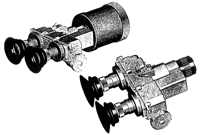
Photo 4. RECON-1 ONV with interchangeable mirror-lens lens
All models of NVG binoculars with the use of EOP-Super II+ and III, as well as the binoculars themselves, are extremely expensive and are intended only for solving special tasks. They are mainly used for piloting helicopters and light motor aircraft at night, as well as for driving special vehicles over rough terrain at high speeds. In fact, to use NVG for aviation needs, it is necessary to conduct expensive and complex tests and certification of the device in the relevant supervisory authorities. To this should be added the need to adapt the aircraft cabin to the use of NVG, special quick-release fastening mechanisms on standard helmets, backup power from the on-board network and the solution of many similar problems. Obviously, the commercial use of such devices is very limited and is justified only as part of expensive equipment. Thus, at present the following models are offered for the needs of aviation: OVN-1 (photo 5), developed by the Special Design Bureau of Night Vision Equipment (SKTB TNV) and mastered by the production of the “Lytkarino Optical Glass Plant” and the State Unitary Enterprise “Alpha” (factory index — Alpha-2031) and GEO-NVG-III, developed by Geofizika-NV. The specified models have the maximum characteristics for existing NVGs. Since 1988, SKTB TNV has been developing helicopter night goggles (HNV) for piloting a helicopter. The MI-8 model with an adapted cabin was called the MI-8MTV-5. Subsequently, the Alfa State Unitary Enterprise significantly improved the HNV, using optical units of lenses and eyepieces with better characteristics. In addition, the input lenses of the modernized HNV Alfa-2031thin-film interference filters, the so-called «minus-blue», are applied, which help to avoid flare from bright light sources and homogeneous surfaces with a high reflection coefficient (water surface, snow field, etc.) at wavelengths up to 630 nm. In order to achieve tightness, the design of the case has also been slightly modified. The need for such a solution was identified when the image intensifier failed during tests at high humidity. The resulting edited GUP «Alpha» OVI are purchased not only to ensure piloting of helicopters of rescue services, the Ministry of Internal Affairs and the Armed Forces during flights at night, but also by representatives of agricultural and transport aviation for field dusting, air cargo transportation to remote areas with landings on unequipped sites. Interest in aviation glasses is also shown by pilots of light motor aircraft of private companies, for whom the possibility of piloting in night conditions will provide greater flexibility in servicing clients. As for the GEO-NVG-III, this model undergoes comprehensive testing.The cost of such equipment, when equipped with a corresponding aviation helmet and on-board power supply devices, exceeds $10,000; the cost of adapting a helicopter cabin to use NVG is more than an order of magnitude higher than this figure. To reduce the cost of NVG, two Super II+-generation image intensifier tubes can be installed in them. However, the photocathodes of these image intensifier tubes have 2-3 times lower sensitivity and their use for piloting aircraft does not ensure observation of obstacles, such as power transmission line wires, mast tops, and poles at the required distances, taking into account the piloting speed on moonless nights. By the way, the VN with two EOP-III should provide general piloting in conditions of natural night illumination of 1-10-3 lux (cloudy sky, no moonlight), and detection of obstacles at illumination of 5-10-3 lux (starlight, up to 1/4 of the moon), average piloting speed of 100 — 200 km/h and average flight altitude of about 50 — 100 m at a distance of 0.5 km — large-sized objects (for example — a truck against the background of green grass), at a distance of over 300 m — power transmission poles. Glasses with the Super II+ image intensifier obviously do not satisfy the first part of these conditions.
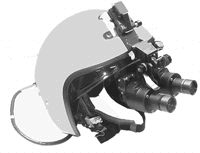
Photo 5. Helicopter night goggles OVN-1
When driving vehicles, especially when maneuvering heavy special equipment, when it is necessary to ensure a stereoscopic vision effect while maintaining high ergonomic characteristics, a binocular scheme using two Super II+ image intensifiers is optimal. To perform such tasks, Alpha specialists proposed a modernized version of the OVI, which received the index A-2121 (photo 6), but this device has not found wide application. Currently, pseudo-binocular OVIs are used to drive special equipment at night.

Photo 6. OVN A-2121
The modest selection of binocular night vision goggles designed for professional tasks is compensated by the presence of several models of zero generation NVGs on the shelves. Hunters and sportsmen show the greatest interest in such models, considering their characteristics to be quite sufficient for ensuring covert movement and orientation on the ground. Of course, on moonless nights, these goggles are effective only with IR illumination. Among the popular models, it is worth mentioning Dipol-2MK, developed and manufactured by the company «Dipol» (Vitebsk, Republic of Belarus) and Orion-1, one of the early developments of SKTB TNV for the needs of the Armed Forces. The latter are produced by the Moscow company «Metron» under the index NG111M and in the Moscow region PO «Lytkarinsky Optical Glass Plant» («LZOS», Lytkarino), with index ON1×20(photo 7). The use of a binocular scheme in these devices, i.e. the use of two optoelectronic paths, is predetermined by the insufficient characteristics of the zero-generation image intensifier tubes, especially the low gain/conversion coefficient of the light flux. The best results in the «zero» class are shown by the B-8, with the use of which the most popular models of cheap domestic ONVs are produced. The advantages of the Dipole devicesIt should also include the presence of a similar monocular, equipped with a headband and allowing the device to be installed in front of both the left and right eyes. This model has the best price/quality ratio for solving non-professional tasks *. Much less often, on the shelves of stores in the European part of Russia you can find glasses Kreml-66 and Kreml-99, produced by «Katod» and also having monocular implementations. More expensive ORION-2, the developments of SKTB TNV and the manufactured «LZOZ» with two EOP-I have a significantly lower demand on the market, since their price is beyond the preferences of consumers.
* Note: Author's assessment.
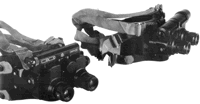
Photo 7. Device OH1×20
In conclusion of the discussion of the NVG models offered on the domestic market, a few words should be said about the masks used (in night vision practice, they are usually called a headband). This issue is important due to the significant weight of the glasses — about 0.5 kg, which seriously affects the cervical spine when worn for a long time. Complex problems include significant variations in the anthropometric parameters of the human head, the reliability of the fastening elements and adjustment mechanism, the reaction of the skin of the face and head to contact with the materials of the headband, etc. Currently, Russian manufacturers produce two standard headbands, and both of them have received complaints from users. The mask originally developed for the needs of the Armed Forces is made of plastic, has a box-shaped rectangular shape and is attached to the operator's face using fabric straps that encircle the head. To avoid contact of the plastic with the face and to ensure ease of fastening, the inside of the mask is glued with soft pads made of thin, well-tanned leather. This mask almost completely covers the operator's face, which evenly distributes the weight of the glasses on the facial bones and reduces pressure on the cervical vertebrae. In addition, the mask partially covers the face from dust, snow, etc. The glasses are attached to the side brackets of the mask using special nuts, which allows them to be adjusted by an angle of ± 10 ° and provides adjustment of the eyepieces' distance. The design of this mask does not provide for folding and quick-release mechanisms. Particularly often criticized is the unreliability of the headband straps' fixation with metal buckles and the operator's field of vision, which is constantly blocked by the device. The headband developed and manufactured by «Dipol» for its ONV is considered more convenient. It is a leather-covered metal half-hoop to which appropriately modified parts of the internal insert of a regular helmet are riveted, used to ensure safety at construction sites and when working in mines. The headband is firmly fixed to the head with Velcro locks. To relieve the neck, a belt is used, which is fixed on the chin. For the user's convenience, a soft cushion made of thin leather is also used, glued to the back of the hoop. This design is equipped with a folding and quick-release mechanism, providing all the necessary adjustments, with the exception of angle adjustment. During operation, the operator's face remains open. The disadvantage of this headband is the problem of joint use with a helmet, hard hat or headgear, with the exception of a knitted cap, of course. Nevertheless, today the Armed Forces prefer to use this option. Their original headband models are produced by «Katod» for the Kremlin and «LOMO». The latter, in some sense, resembles the American model used for the AN/PVS-7 NVG of all modifications. The design of these headbands also matches the headband with a quick release unit and has all the necessary adjustments, except for the tilt option.
An inspection of the park of pseudo-binocular NVG designs would not be complete without mentioning binoculars. Such devices do not provide a stereo effect, but are significantly cheaper due to the use of one image intensifier and lens. The Kazan Optical and Mechanical Plant (KOMZ) successfully operates in this class of devices. The most popular is the Baigysh family, headed by the famous Baigysh-6 model.(photo 8). For image distribution in these models, not an eyepiece is used, but a special lens system with a prism, providing the effect of «panoramic guidance» of the image of the EOP screen (i.e., a panoramic eyepiece). Baigish-6is one of the most widely distributed pseudo-binoculars and is successfully sold in the Russian Federation and abroad, although it has significant dimensions by modern standards. Similar NVDs were developed on the basis of the II-generation EOP with fairly high characteristics and to date there is a good demand for them due to a very high quality/price ratio. Of course, binoculars are used as portable devices for observation «handheld» or on a tripod. The LYNX 10M-01 model by TURN (Moscow) is designed somewhat differently and can be supplied with either a regular or a panoramic eyepiece (photo 9). A similar solution is offered by Moscow JSC Dedal-NV (trademark Dedal) in the Dedal-41 model (photo 10). Both devices use an EOP-II with a photocathode diameter of 25 mm, in Dedal-41, in addition, the installation of an IR spotlight is provided. As a development of this model, we can consider the new product of 1999 -Dedal-43 with a mirror-lens objective. A similar option is offered by NPK «Pusk» in the PNN-03 model, but with somewhat more modest lens parameters. The cost of the vast majority of NVD models with generation II EOP is within $1500-2000.
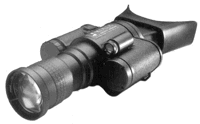
Photo 8. Baigish-6 pseudo-binocular binocular (export version).
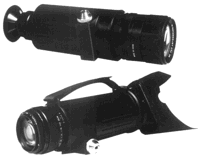
Photo 9. LYNX 10M-01 device with a regular and panoramic eyepiece

Photo 10. Dedal-41 pseudo-binocular
The 1PN-94 model is also a pseudo-binocular binocular., manufactured by KOMZ (photo 11). In essence, the ONV eyepiece system is used here, made together with the objective in a non-detachable polystyrene housing. A similar option is offered by Alpha in the Alpha-3122 model with an objective from the Krasnogorsk plant. This model has excellent characteristics, with the exception of the weight of 1.2 kg, due to the significant weight of the objective — 630 g.
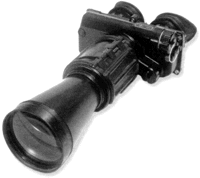
Photo 11. Binocular-pseudo-binocular 1PN-94
The rarest devices on the domestic market are full binoculars and, oddly enough, monoculars designed to provide elite units of the Armed Forces and the Ministry of Internal Affairs. Of course, we mean night vision devices with an EOP of generation II+ and higher. The use of such binoculars is limited by their high price and significant weight and size parameters.
Based on the ratio of energy and cost characteristics, it is most expedient to use pseudo-binocular systems, which have filled the corresponding niche in the market. The author knows of only one successful design of binoculars — Kremlin-3 with two II+ image intensifiers, manufactured by «Katod» using two small-sized mirror-lens objectives.
As for the «special forces» monocular, the reason for its absence in service is technological problems associated with the development of a fiber-optic reversing element in assembly with an image intensifier. Initially, it was believed that pseudo-binocular ONV II+ were sufficient for solving existing tasks for special forces.
The need for an image intensifier II-III generations with a built-in «reversing element» became apparent only during the development of aviation glasses. Currently, the State Unitary Enterprise «Alpha» has developed and is producing the monocular A-9021(photo 12), which is the most ergonomic of the night vision devices available on the world market (weight — 250g!) with the best price/quality ratio.
In terms of configuration, the A-9021 resembles the American M982/3, manufactured by IIT/Litton, but is equipped with not one, but two AA-type power sources. The monocular has a lens unified with the 1PN74, and can be supplied with an afocal attachment developed for these night vision devices, as well as with an adapter for photography.
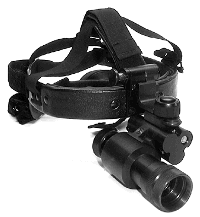
Photo 12. Monocular A-9021
The largest segment of the NVG market in terms of the number of manufactured products is the market for zero-generation devices. Most of the enterprises of the optical industry in Russia operate here. Such designs are not intended for professional activities.
The largest number of viewfinders is presented here, from small monoculars that fit easily in the hand from the Krasnogorsk Optical and Mechanical Plant named after Zverev, one of the largest manufacturers of products of this type, to «tubes» and binoculars with 3-4x magnification, manufactured by ROMZ, Metron, Katoda and many other companies.
Among similar NVGs for general civilian use, devices with a piezoelectric element that do not require batteries or accumulators are very popular.
Read the rest of the article — «Market Review of Night Vision Devices of Russian Production.»

Добавить комментарий